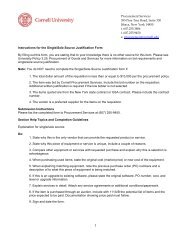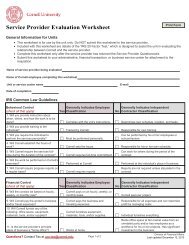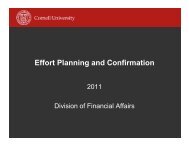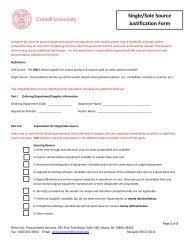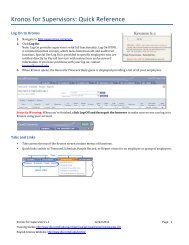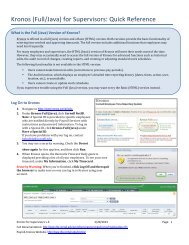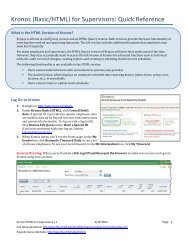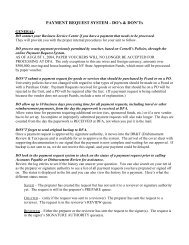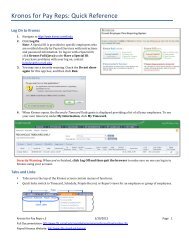Transaction and Account Review Guidelines
Transaction and Account Review Guidelines
Transaction and Account Review Guidelines
You also want an ePaper? Increase the reach of your titles
YUMPU automatically turns print PDFs into web optimized ePapers that Google loves.
<strong>Guidelines</strong> for Department Administrators Working with Business Service CentersTopics: <strong>Account</strong> <strong>Review</strong> <strong>and</strong> Financial <strong>Transaction</strong> <strong>Review</strong>ContextThis document has been prepared to assist department administrators in the areas offinancial transaction review <strong>and</strong> account review whose department is supported by abusiness service center. The guidelines are not intended to be an exhaustive guide formanaging all transactions <strong>and</strong> all accounts, but rather should be used to support <strong>and</strong>inform judgments department administrators must make on a continual basis.<strong>Account</strong> <strong>Review</strong>General OverviewThe reliance upon a BSC for financial transaction processing or financial managementactivities does not remove financial stewardship <strong>and</strong> management oversightresponsibilities for a department from the department administrator. Specific actionsmay vary depending on the support provided by the BSC, but fundamental financialoversight responsibilities remain at the unit level. Department administrators shouldhave current knowledge of the purpose <strong>and</strong> use of department accounts, the level of riskassociated with individual accounts <strong>and</strong> the related transaction activity, <strong>and</strong> confidencein the reasonableness of account balances.Underst<strong>and</strong>ing <strong>Account</strong> Activity <strong>and</strong> <strong>Account</strong> RiskThe account review process a department administrator should adopt should vary basedon the nature of the accounts <strong>and</strong> the associated risks.• Underst<strong>and</strong> the accounts you are responsible for.o How are accounts initiated <strong>and</strong> established for your department?o <strong>Account</strong> purpose – what is it used for?o Nature of account – restricted/non-restricted, amount of activity to expect,size of budget or anticipated transaction level (in terms of dollars <strong>and</strong> #transactions), types of transactions <strong>and</strong> vendorso Who is the account owner – i.e. who has primary responsibility/authorityfor deciding how the money is spent?o Who has primary financial management responsibility for the account?o How are transactions reviewed <strong>and</strong> controlled before being posted to theaccount?o What is the current account balance <strong>and</strong> is this account balance reasonablegiven the timing <strong>and</strong> duration of funds received, the cycle of businessactivity, etc?o At least quarterly, review the schedule of departmental balances toidentify any new accounts you may not be aware of.• Determine the risk level regarding the account<strong>Account</strong> risk refers to the level of concern that errors, problems orirregularities might occur regarding account activity <strong>and</strong> the assessment ofhow such circumstances could negatively impact the account user,department, college, <strong>and</strong>/or university. The risks associated with the1 8/5/05 pjs
<strong>Guidelines</strong> for Department Administrators Working with Business Service CentersTopics: <strong>Account</strong> <strong>Review</strong> <strong>and</strong> Financial <strong>Transaction</strong> <strong>Review</strong>miscoding a transaction to the wrong unrestricted account is likely muchless than miscoding the same transaction to the wrong restricted fundsaccount.The two most common factors to consider when evaluating risk are:o Funding source – unrestricted vs. restricted fund; restricted funds aretypically considered higher risk due to explicit limitations on how thefunds can or must be used <strong>and</strong> the potential impact on future fundingsupporto Nature of transaction activity – scheduled payroll <strong>and</strong> routine nonpersonnelactivity are generally less risky than unscheduled <strong>and</strong> nonroutineactivity.Although often related, the level of risk associated with an account may differfrom the level of risk associated with the underlying transaction activity. Forexample, specific transactions may carry greater risk due to the nature of theactivity, past history with the vendor or initiator of the transaction than therisk associated with the account <strong>and</strong> related funding source.The assessment <strong>and</strong> management of risk requires thoughtful judgment by thedepartment administrator of the unique considerations for each account. Allaccounts must periodically be reviewed however the degree of risk associatedwith the account can help determine how often an account should be reviewed<strong>and</strong> how detailed that review should be. Department administrators areencouraged to obtain training through DFA (e.g. Course: FIN 104 FinancialStewardship <strong>and</strong> Compliance at Cornell) to further underst<strong>and</strong> account risks<strong>and</strong> responsibilities.The following is a description of various types of accounts <strong>and</strong> the degree ofrisk typically associated with each. This is not an exhaustive list of all typesof accounts nor should it be used as a definitive classification for a particulartype of account.Less Risk• Unrestricted Department Operating – no restrictions regarding useof funds; low risk of external reviewModerate Risk• Petty Cash <strong>Account</strong>s – balance is generally small but the fact that itis cash can lead to loss.• <strong>Account</strong>s Receivable <strong>Account</strong>s – represents a balance due to theUniversity. Unbilled or uncollected receivables is cash lost for theunit <strong>and</strong> the University.• Unrestricted Gift <strong>Account</strong>s – reports to sponsors not usuallyrequired; indefinite term dates; not restricted in use.2 8/5/05 pjs
<strong>Guidelines</strong> for Department Administrators Working with Business Service CentersTopics: <strong>Account</strong> <strong>Review</strong> <strong>and</strong> Financial <strong>Transaction</strong> <strong>Review</strong>Highest Risk• Sponsored Research <strong>Account</strong>s Including Cost Sharing <strong>and</strong><strong>Account</strong>s Receivable– Terms are restrictive <strong>and</strong> requirementsspecific.• Restricted Gift <strong>Account</strong>s – in situations where the donor wants allexpenses accounted for <strong>and</strong> there may be little departmentdiscretion. May also be for a limited time period.<strong>Account</strong> <strong>Review</strong> StrategiesAn overall written procedure defining how accounts will be reviewed should beestablished. Putting the account review procedure in written form will facilitatethe review process, help ensure the review process is thorough <strong>and</strong> complete,provide a basis for staff training, <strong>and</strong> ensure consistency. The plan shouldconsider <strong>and</strong> address the following:• Determine how frequently the account balance should be reviewed (e.g.weekly, monthly, quarterly). <strong>Account</strong> balances should be reviewed at leastquarterly.• Determine who is responsible for what transaction activities <strong>and</strong>/or accountreviews.o Are you relying on a business service center for basic review of yourunit accounts <strong>and</strong> transaction activity? If so, how frequent <strong>and</strong> howcomplete is the review?o Are you expecting another staff/faculty person to review the accountregularly <strong>and</strong> if so, is the review adequate?o Set <strong>and</strong> communicate expectations to all parties. Responsibilities for theBSC should be documented as part of a formal service agreement.• Define the basic strategy for account review. The amount of detail you needto review depends on the associated risks. Suggested strategies include:o Calculate change in balance from beginning to end of the reviewperiod (monthly, quarterly or annually). Determine if change in thebalance make sense based upon your knowledge of the account.o Investigate any unusual or unexpected account balances orfluctuations.o Considering the level of risk associated with the account <strong>and</strong> theamount of transaction review previously performed, scan transactionactivity for appropriateness against the terms of the account orsponsored award if applicable. Refer to the transaction review sectionof this document for further discussion.o <strong>Review</strong> accounts with deficit account balances <strong>and</strong> establish anexplicit plan to eliminate the deficit or highlight the issue for attentionby your department head.3 8/5/05 pjs
<strong>Guidelines</strong> for Department Administrators Working with Business Service CentersTopics: <strong>Account</strong> <strong>Review</strong> <strong>and</strong> Financial <strong>Transaction</strong> <strong>Review</strong>o <strong>Review</strong> inactive accounts with available funds periodically todetermine if such resources could be used for current funding needs.<strong>Transaction</strong> <strong>Review</strong>General OverviewFor purposes of these guidelines, a financial transaction is defined as any economicevent that is ultimately recorded or should be recorded in the university’s generalledger. In departments these activities include the receipt of funds, disbursement orinternal transfer of funds, <strong>and</strong> any binding commitment regarding the acquisition ofgoods or services or the providing of services to others.With the establishment of business service centers (BSC) in units across campus, theprocessing of transactions through university systems, including final authorization, istypically performed or directed by BSC staff. This processing responsibility generallyincludes reviewing transactions for reasonableness of purpose, business need, <strong>and</strong>amount, reviewing for compliance with university policy, account or sponsored awardrestrictions, reviewing adequacy of supporting documentation, ensuring any necessarydepartment review has occurred, <strong>and</strong> final authorization of the transaction. The relatedprocesses are intended to ensure that the basic internal control elements of validity,accuracy, completeness, proper classification, proper accounting, <strong>and</strong> authorization aresatisfied. Given that these processes occur prior to a transaction being fully executedthey are referred to as pre-transaction processing <strong>and</strong> are considered preventive internalcontrol procedures.Department administrators rely on BSC staff for their unit’s transaction support, butstill retain general stewardship <strong>and</strong> management oversight responsibilities for financialactivity in the department. Department administrators can generally meet theseresponsibilities by establishing clear expectations, responsibilities, <strong>and</strong> authorizationlevels for the initiation of transactions (preventive measures) <strong>and</strong> through strong posttransaction(i.e. after the transaction has been executed) review procedures.Underst<strong>and</strong> Business Activity <strong>and</strong> Related RisksTo provide proper management oversight of transaction activity a departmentadministrator must underst<strong>and</strong> the nature of transactional activity in their unit. This isessential regardless of the fact that a BSC processes transactions for the unit. Theimportance of relying upon a strong underst<strong>and</strong>ing of the nature of departmentaltransactions becomes more critical as the direct involvement with individual transactionprocessing decreases.Department administrators should build a strong underst<strong>and</strong>ing of the following:• Initiating source or event – what is the triggering action causing purchasingactions <strong>and</strong> who are the appropriate individuals to initiate the purchases;• Type of expenditures <strong>and</strong> the related business purposes the generally occur;• Type of revenue received <strong>and</strong> the underlying source activities;4 8/5/05 pjs
<strong>Guidelines</strong> for Department Administrators Working with Business Service CentersTopics: <strong>Account</strong> <strong>Review</strong> <strong>and</strong> Financial <strong>Transaction</strong> <strong>Review</strong>• Frequency of expenditures <strong>and</strong> revenue receipts;• Recurring or non-recurring nature of the transactions – recurringtransactions are those that occur on a fairly regular schedule <strong>and</strong> arereasonably predictable in volume <strong>and</strong> amount. Payroll or monthlycommunication bills are examples of recurring transactions.• Unusual or exception transactions – underst<strong>and</strong> what activity wouldconstitute an unusual or exception transaction that might require additionalreview or special h<strong>and</strong>ling.• <strong>Transaction</strong> risk – underst<strong>and</strong> the financial, compliance, <strong>and</strong> operational riskof the business activities. Consider the source of funding (restricted vs.unrestricted), compliance requirements for the type of transaction,department or management expectations, established unit-based transactionreview or authorization requirements, <strong>and</strong> past history or knowledge ofpotential problems (e.g. conflict of interest or commitment).This underst<strong>and</strong>ing is typically built through discussion with appropriate faculty,administrators, <strong>and</strong> other staff, through review of contractual agreements, <strong>and</strong> throughregular observance of department activity.Strategies for Managing <strong>Transaction</strong> ActivityThe strategies for managing transaction activity generally fall under two categories –preventive strategies <strong>and</strong> post-transaction review strategies.Preventive Strategies• Develop an overall plan for how individual transactions <strong>and</strong>/or categories oftransactions will be managed. Specifics of the plan may vary based on thetype of transaction, risk associated with the transaction, dollar amounts, orpossibly other variables. Consider the amount of expected scheduled orroutine transactions (e.g. regular payroll, benefits, communication, or othermonthly bills, etc.) versus non-routine activity in developing a transactionreview strategy.The overall plan should also consider the relative cost of a possible error orchance of an irregularity. For example, the cost of a transaction beingmisclassified between two unrestricted accounts may be minimal <strong>and</strong> notworth reviewing.• Using the overall plan as a guide, establish a written agreement with theBSC clearly defining responsibilities for transaction review <strong>and</strong> processing.This agreement should define any unit specific processing or authorizationrequirements that BSC staff must adhere to including any special h<strong>and</strong>lingof transactions in higher risk categories.• Communicate to department faculty <strong>and</strong> staff their responsibilities relativeto initiating <strong>and</strong> processing transactions, including any department definedrequirements for review or authorization on particular items. The primary5 8/5/05 pjs
<strong>Guidelines</strong> for Department Administrators Working with Business Service CentersTopics: <strong>Account</strong> <strong>Review</strong> <strong>and</strong> Financial <strong>Transaction</strong> <strong>Review</strong>responsibility for ensuring a transaction is a valid university transaction withan acceptable business purpose rests with the initiator <strong>and</strong> this responsibilityshould be periodically reinforced through department communication.Post-transaction <strong>Review</strong> Strategies• Use exception reporting to identify unusual activity <strong>and</strong> possible errors orirregularities. Exception reporting consists of routinely generated reportsintended to identify higher risk activity based on pre-defined criteria. Suchcriteria often includes specific dollar thresholds, certain types of transactionobject codes, particular vendors, particular employee activity, certainaccount or funding sources, etc. For low risk activity, exception analysis issometimes performed most efficiently across a range of accounts (e.g.categorized or listed by object code, by vendor) rather than by eachindividual account.• Scan activity to identify transactions requiring further inquiry <strong>and</strong> review.The scanning process may be performed most efficiently <strong>and</strong> effectively bygrouping transactions in some manner such as object code, vendor, dollaramount, similar accounts, etc.o for payroll <strong>and</strong> benefits, the 189 report or labor distribution detail;• scan payroll charges for consistency in amounts to the previousperiod <strong>and</strong> appropriateness of employees paid• scan the benefits charges for consistency to the previous period <strong>and</strong>proper ratio to payroll expenseo scan the non-payroll expenses for unusual vendors, amounts or timingor unexpected transaction activityNOTE: Scanning transactional activity does not require departmentadministrative staff to review the supporting documentation for alltransactions, most of which is likely on file with the BSC. However, forunusual or unexpected transactions it may be necessary to review thesupporting documentation in order to be satisfied with theappropriateness of the transaction.• <strong>Transaction</strong>al risk will vary by the nature of the funding source, the amountof the account balance <strong>and</strong> other variables impacting the business riskassociated with the account. Specific post-transaction review strategiesshould be developed for higher risk accounts. Further discussion on possiblestrategies is provided in the account review section of this document.6 8/5/05 pjs




